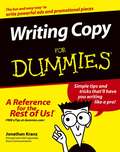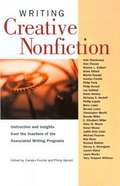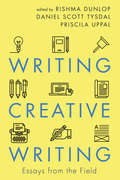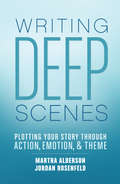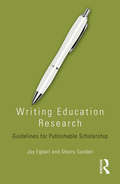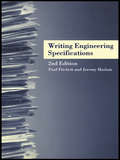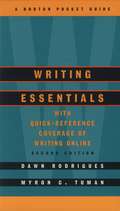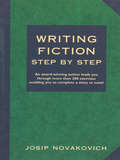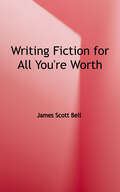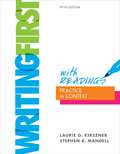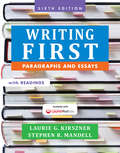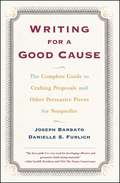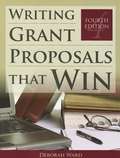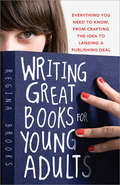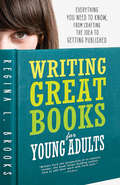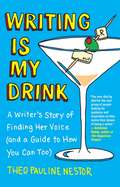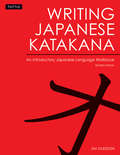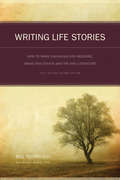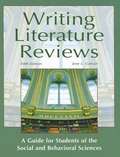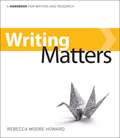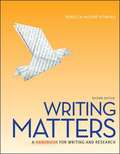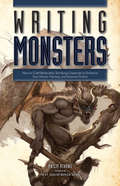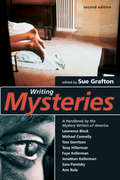- Table View
- List View
Writing Copy For Dummies
by Jonathan KranzTips on writing to consumers and business-to-business Create captivating, results-oriented, sales-generating copy Need to produce winning copy for your business? This fast, fun guide takes you through every step of a successful copywriting project, from direct mail, print ads, and radio spots to Web sites, articles, and press releases. You'll see how to gather crucial information before you write, build awareness, land sales, and keep customers coming back for more. Discover How To: * Write compelling headlines and body copy * Turn your research into brilliant ideas * Create motivational materials for worthy causes * Fix projects when they go wrong * Land a job as a copywriter
Writing Creative Nonfiction: Instruction and Insights from the Teachers of the Associated Writing Program
by Philip Gerard Carolyn ForchéExperience the power and the promise of working in today' most exciting literary form: Creative Nonfiction Writing Creative Nonfiction presents more than thirty essays examining every key element of the craft, from researching ideas and structuring the story, to reportage and personal reflection. You'll learn from some of today's top creative nonfiction writers, including: Terry Tempest Williams - Analyze your motivation for writing, its value, and its strength. Alan Cheuse - Discover how interesting, compelling essays can be drawn from every corner of your life and the world in which you live. Phillip Lopate - Build your narrator–yourself–into a fully fleshed-out character, giving your readers a clearer, more compelling idea of who is speaking and why they should listen. Robin Hemley - Develop a narrative strategy for structuring your story and making it cohesive. Carolyn Forche - Master the journalistic ethics of creative nonfiction. Dinty W. Moore - Use satire, exaggeration, juxtaposition, and other forms of humor in creative nonfiction. Philip Gerard - Understand the narrative stance–why and how an author should, or should not, enter into the story. Through insightful prompts and exercises, these contributors help make the challenge of writing creative nonfiction–whether biography, true-life adventure, memoir, or narrative history–a welcome, rewarding endeavor. You'll also find an exciting, creative nonfiction "reader" comprising the final third of the book, featuring pieces from Barry Lopez, Annie Dillard, Beverly Lowry, Phillip Lopate, and more–selections so extraordinary, they will teach, delight, inspire, and entertain you for years to come!
Writing Creative Writing: Essays from the Field
by Priscila Uppal Rishma Dunlop Daniel Scott TysdalEssential and engaging essays about the joys and challenges of creative writing and teaching creative writing by a host of Canada’s leading writers. Writing Creative Writing is filled with thoughtful and entertaining essays on the joys and challenges of creative writing, the complexities of the creative writing classroom, the place of writing programs in the twenty-first century, and exciting strategies and exercises for writing and teaching different genres. Written by a host of Canada’s leading writers, including Christian Bök, Catherine Bush, Suzette Mayr, Yvette Nolan, Judith Thompson, and thom vernon, this book is the first of its kind and destined to be a milestone for every creative writing student, teacher, aspirant, and professional.
Writing Deep Scenes: Plotting Your Story Through Action, Emotion, and Theme
by Martha Alderson Jordan RosenfeldTake a Deep Dive into Plot and Scene and Improve Your WritingWhether you're planning your first novel or have already written a first draft, you need to master the concepts of plot and scene to truly realize your story's potential. Writing Deep Scenes teaches you how to write strong, layered, and engaging scenes--the secret to memorable, page-turning plots. It's filled with practical tools for building layers and nuance into your scenes, employing the right scene types at the right junctures, and developing a profound understanding of how plot and scene intertwine.Inside you'll learn:How scenes are comprised of three key layers: action, emotion, and theme.How to recognize each layer and weave them seamlessly into a scene.How to develop an intricate relationship between the action and emotion in every scene.How thematic imagery embedded in scenes increases a story's tension and contributes to the story's meaning.Using contemporary examples from a variety of genres, Writing Deep Scenes provides an effective method for plotting at the scene level. Use these techniques and enrich your fiction and memoirs with page-turning suspense and pathos, and explore new depths in every story you write.
Writing Doesn't Have To Be Lonely: 14 Ways to Get the Help of Other People When You Write
by Lawrence WeinsteinOne big reason many people dread to write is that their writing habits don't satisfy their inborn need for company. For many, their writing will go best when they alternate the solitary times with times of companionship and sharing.<P> This is not a book just about the company and help available for writing at school, either. The array of types of help described here should prove valuable in any environment.
Writing Education Research: Guidelines for Publishable Scholarship
by Joy Egbert Sherry SandenFor both new academics and those with some experience, writing articles of publishable quality can be particularly challenging. Developing the necessary skill set requires useful information, hard work, and the type of direction infrequently offered in research methods courses, leaving researchers to piece together resources on their own. This book addresses this critical topic in a format that is easy to teach and understand. It is a practical volume that teaches researchers how to identify their audience, clearly state the nature of their work, provide exceptional literature reviews, cite appropriately, and explicate their research. Beginning each chapter with reviewer comments, Writing Education Research is designed to help scholars understand both how to write effective research reports and how to get published. Practice exercises and resource lists in each chapter offer easy-to-access information about the review and publication process. A perfect accompaniment to standard research courses, this practical book demystifies the writing process for anyone looking to publish articles, chapters, or papers in education.
Writing Engineering Specifications
by Paul Fitchett Jeremy HaslamEngineers need to understand the legal and commercial context in which they draw up technical specifications. This thoroughly up-dated edition of Haslam's successful Writing Engineering Specifications provides a concise guide to technical specifications and leads the reader through the process of writing these instructions, with clear advice to help the student and professional avoid legal disputes or the confusion and time wasting caused by poor drafting. Designers and project managers should find this invaluable, and it should be helpful to insurers, lawyers, estimators and the like.
Writing Essentials: A Norton Pocket Guide
by Dawn Rodriguez Myron C. TumanWriting Essentials combines the essentials of grammar, punctuation, mechanics, and documentation with practical suggestions for writing online.<P> From online prewriting, drafting, group workshopping, revising, and editing, to database searching, navigating the Internet, documenting online sources, and designing documents, Writing Essentials offers practical, hands-on advice for using computers throughout the writing process.
Writing Fiction Step by Step: An Award-Winning Author Leads You Through More than 200 Exercises Enabling You to Complete a Story or Novel
by Josip NovakovichWriting Fiction Step by Step gives you more than 200 exercises that will sharpen your writing skills while helping you develop complete short stories, even novels. In this sequel to his very popular Fiction Writer's Workshop, Whiting Award-winning author Josip Novakovich shows you that writing fiction is about making connections–between character and plot, setting and conflict, memory and imagination. You'll make these connections by linking the exercises. A character invented in chapter two can appear in a scene outlined in chapter eight and can speak in a voice developed in chapter ten. Embark on a unique writing journey and learn step by step how to craft fiction that captivates readers.
Writing Fiction for All You're Worth
by James Scott BellTake your fiction to that next level, where agents and editors sit up and take notice - and where readers keep coming back for more! This book contains the best of James Scott Bell's articles and blog posts on writing, easily searchable under these headings: The Writing World, The Writing Life, and The Writing Craft. And you'll get never before published material, including a first-ever look into Jim's secret writing notebook, the manual he put together over the years for his own use in writing numerous bestsellers. For the first time he's sharing a glimpse into the notes he compiled on his way to publishing success. Plus, a special module on getting into e-publishing, which is a must read if you want to have a career selling e-books successfully.
Writing First With Readings: Practice In Context
by Laurie G. Kirszner Stephen R. MandellBest-selling authors and veteran college writing instructors Laurie Kirszner and Stephen Mandell believe that students learn to write best when they use their own writing as a starting point. In Writing First with Readings: Practice in Context, designed for the paragraph to essay course, Kirszner and Mandell take seriously the ideas and expressive abilities of developmental students, as well as their need to learn the rules of writing and grammar. Visual writing prompts that open every chapter get students writing immediately. By moving frequently between their own writing, writing models and instruction, and workbook-style mastery exercises, students get constant reinforcement of the skills they are learning. Thoughtful chapters on college success, research, and critical reading, along with high-interest essays, round out the text, making it the perfect introduction to college writing.
Writing First with Readings
by Laurie G. Kirszner Stephen R. MandellBest-selling authors and veteran college writing instructors Laurie Kirszner and Stephen Mandell believe that students learn to write best when they use their own writing as a starting point. In Writing First with Readings: Paragraphs and Essays, the authors take a simple yet effective approach to helping students improve their writing skills: visual writing prompts open every chapter and get students writing immediately. Then, throughout the chapter, students move between their own writing, writing models and instruction, and workbook-style mastery exercises so that they continually revise, rewrite, and improve their own writing. It is this formula that makes writing instruction meaningful and accessible for students. Thoughtful chapters on academic writing and success, research, and critical reading, along with high-interest essays, round out this new edition, making it the perfect introduction to college writing.
Writing For a Good Cause
by Joseph Barbato Danielle FurlichFilled with tips and survival skills from writers and fund-raising officers at nonprofits of all sizes, Writing for a Good Cause is the first book to explain how to use words well to win your cause the money it needs. Whether you work for a storefront social action agency or a leading university, the authors' knowledgeable, practical advice will help you: Write the perfect proposal -- from the initial research and interviews to the final product Draft, revise, and polish a "beguiling, exciting, can't-put-it-down and surely can't-turn-it-down" request for funds Create case statements and other big money materials -- also write, design, and print newsletters, and use the World Wide Web effectively Survive last-minute proposals and other crises -- with the Down-and-Dirty Proposal Kit! Writing for a Good Cause provides everything fund raisers, volunteers, staff writers, freelancers, and program directors need to know to win funds from individual, foundation, and corporate donors.
Writing Grant Proposals That Win
by Deborah WardThe Fourth Edition is a thorough update with all new charts, graphs, tables, and figures; as well as new examples and coverage of current topics. Students will come away with a clear understanding of how reviewers function and what they are looking for in proposal sections, in addition to what is needed to maximize every aspect of the proposal. The text is loaded with useful tips that will enable your students to hit the ground running, including how to assess a program announcement and ensure each requirement is addressed; condense your entire proposal into a brief but compelling abstract; determine what appendices to include (and in what form) for maximum impact; adequately describe project dissemination and continuation plans; use technology -- including desktop publishing, graphics, color, and spreadsheets for budget development -- to enhance your proposals; and structure your proposal to increase your chance of winning.
Writing Great Books for Young Adults
by Regina BrooksFrom a top young adult literary agent, Writing Great Books for Young Adults is the only guide on how to write for young adults and gives writers the advice they need to tap this incredible market.
Writing Great Books for Young Adults
by Regina BrooksBreak into the Bestselling Young Adult Market with this IndispensableGuide!Whether you're just getting started or are on the hunt foran agent or publisher, Writing Great Books for Young Adults is your completeinsider source on how to succeed in the flourishing world of YA fiction andnonfiction. In this updated and revised edition, veteran literary agent ReginaL. Brooks offers invaluable advice for YA writers on everything from shapingyour novel to crafting the perfect pitch for your book.Learn How To: Develop an authentic, engaging voice and writing style Construct dynamic plots that will resonate with readers Avoid common pitfalls related to tone and point of view Navigate the emerging genres of YA nonfiction and New Adult Create an exceptional query letter and proposal that willgrab the attention of agents and publishersYou'll also discover how successful film adaptations like Harry Potter and The Hunger Games have broadened the market for your book.Filled with tips and advice from agents, editors, and popular YA authors,Writing Great Books for Young Adults is your ticket to an incredible YA career!"Brooks offers writers who are serious about attractingteen readers solid guidance through the creation process of writing YA fiction."--LibraryJournal
Writing Is My Drink
by Theo Pauline NestorWhether you're aiming for a New York Times bestseller or a short personal essay to share with family and friends, a popular blogger and memoirist shows you the way in this witty writing guide and disarmingly candid account of discovering her own voice."Theo Pauline Nestor has a big heart and a real feel for the pain and craziness of human life," wrote Pulitzer Prize-winning author Frank McCourt. This couldn't be truer in Writing Is My Drink, part memoir, part inspirational writing guide that tells the absorbing, poignant, and at times hilarious story of how Nestor found her voice as a writer. Nestor pulls no punches as she tells the stories of her life, from the darkest, most intimate moments, dealing with her alcoholic parents and the deaths of her beloved stepfather and grandmother to experiencing writer's block and the thrilling moment when she first realizes she's written something of value. With sweetness, humor, and charming candor, she shows aspiring writers how to tap into their own stories and unlock their potential. In addition, in her "Try This" sections at the end of each chapter, Nestor challenges you to take risks and deeply consider why you are writing and what you want to achieve. She also discusses successes and failures from her own life to demonstrate the challenges all writers face as well as the joys that come from tackling your dreams. With her witty, compelling, and wonderfully authentic voice, Nestor is an inspiring writing guru, whose own journey is sure to captivate and inspire.
Writing Japanese Katakana
by Jim GleesonThis is an introductory guide and workbook to writing Japanese Katakana.Anybody who is able to master English, with its irregular spellings and idiosyncratic pronunciations, is more than equipped to master written Japanese. The hiragana and katakana syllabaries are purely phonetic characters, which function much like the letters of the English alphabet. In this respect, kana are quite different from kanji characters, which are based on Chinese ideographs and which represent ideas. The katakana syllabary is used primarily to represent borrowed words (from languages other than Chinese), although it is also used for botanical names and is sometimes used in place of hiragana or kanji for emphasis. In some ways, the use of katakana in Japanese parallels the use of italics in English.Writing practice is the most effective method of mastering written Japanese, and the large open format of this workbook is designed to invite the student to pick up a pencil and start writing. Written Japanese comprises two phonetic syllabaries, hiragana and katakana, and a set of kanji characters that are based on Chinese ideographs. This workbook has been carefully designed to facilitate the quick and easy mastery of the 46-character katakana alphabet, making it the perfect tool to begin the process of mastering written Japanese. Each character is introduced with brushed, handwritten and typed samples that enhance character recognition. Extensive space for writing allows maximum practice to facilitate memorization and to ensure proper character formation. Entertaining illustrations and amusing examples of loan-words that use katakana in Japanese writings further reinforce memorization in a fun way. Writing Katakana is tailored to the specific needs of young students of the Japanese language, but is also well suited to beginning students of any age. This workbook contains:grayed-out, trace-over characters for correct character constructionExtensive practice in writing sentences for maximum reinforcementSupplementary explanations, including a brief history of the origin of each character, to foster visual recall.
Writing Japanese Katakana
by Jim GleesonThis is an introductory guide and workbook to writing Japanese Katakana.Anybody who is able to master English, with its irregular spellings and idiosyncratic pronunciations, is more than equipped to master written Japanese. The hiragana and katakana syllabaries are purely phonetic characters, which function much like the letters of the English alphabet. In this respect, kana are quite different from kanji characters, which are based on Chinese ideographs and which represent ideas. The katakana syllabary is used primarily to represent borrowed words (from languages other than Chinese), although it is also used for botanical names and is sometimes used in place of hiragana or kanji for emphasis. In some ways, the use of katakana in Japanese parallels the use of italics in English.Writing practice is the most effective method of mastering written Japanese, and the large open format of this workbook is designed to invite the student to pick up a pencil and start writing. Written Japanese comprises two phonetic syllabaries, hiragana and katakana, and a set of kanji characters that are based on Chinese ideographs. This workbook has been carefully designed to facilitate the quick and easy mastery of the 46-character katakana alphabet, making it the perfect tool to begin the process of mastering written Japanese. Each character is introduced with brushed, handwritten and typed samples that enhance character recognition. Extensive space for writing allows maximum practice to facilitate memorization and to ensure proper character formation. Entertaining illustrations and amusing examples of loan-words that use katakana in Japanese writings further reinforce memorization in a fun way. Writing Katakana is tailored to the specific needs of young students of the Japanese language, but is also well suited to beginning students of any age. This workbook contains:grayed-out, trace-over characters for correct character constructionExtensive practice in writing sentences for maximum reinforcementSupplementary explanations, including a brief history of the origin of each character, to foster visual recall.
Writing Life Stories: How to Make Memories into Memoirs, Ideas into Essays, and Life into Literature - Fully Revised Second Edition
by Bill Roorbach Kristen KecklerHow to Make Memories into Memoirs, Ideas into Essays, and Life into Literature From drawing a map of a remembered neighborhood to signing a form releasing yourself to take risks in your work, Roorbach offers innovative techniques that will trigger ideas for all writers. Writing Life Stories is a classic text that appears on countless creative nonfiction and composition syllabi the world over. This updated 10th anniversary edition gives you the same friendly instruction and stimulating exercises along with updated information on current memoir writing trends, ethics, internet research, and even marketing ideas. You'll discover how to turn your untold life stories into vivid personal essays and riveting memoirs by learning to open up memory, access emotions, shape scenes from experience, develop characters, and research supporting details. This guide will teach you to see your life more clearly and show you why real stories are often the best ones.
Writing Literature Reviews: A Guide for Students of the Social and Behavioral Sciences
by Jose L. GalvanThis easy-to-follow guide instructs students in the preparation of literature reviews for term projects, theses, and dissertations. There are numerous examples from published literature reviews that illustrate the guidelines discussed in this text. New to this edition: Most of the examples have been updated with material from recently published research. Also new: Seven new model literature reviews for discussion and evaluation have been added. Guides students in the preparation of literature reviews for term projects, theses, and dissertations. Chapters are conveniently divided into easy-to-follow guidelines, sequential steps, or checklists. Numerous examples throughout the book show students what should and should not be done when writing reviews. Emphasizes critical analysis of reports of empirical research in academic journals-making it ideal as a supplement for research methods courses. This book makes it possible for students to work independently on a critical literature review as a term project. Nine model literature reviews at the end of the book provide the stimulus for homework assignments and classroom discussions. The activities at the end of each chapter keep students moving toward their goal of writing a polished, professional review of academic literature. New to this edition: Most of the examples have been updated with material from recently published research. Also new: Seven new model literature reviews for discussion and evaluation have been added.
Writing Matters: A Handbook for Writing and Research
by Rebecca Moore HowardWriting Matters unites research, reasoning, documentation, grammar and style in a cohesive whole, helping students see the conventions of writing as a network of responsibilities writers have.
Writing Monsters: How to Craft Believably Terrifying Creatures to Enhance Your Horror, Fantasy, an d Science Fiction
by Philip AthansMonsters are more than things that go bump in the night... Monsters are lurking in the woods, beneath the waves, and within our favorite books, films, and games--and there are good reasons why they appear so often. Monsters are manifestations of our fears and symbols of our society--not to mention they're a lot of fun--but each should serve a purpose and enhance the themes and tension in your fiction. In Writing Monsters, best-selling author Philip Athans uses classic examples from books, films, and the world around us to explore what makes monsters memorable--and terrifying. You'll learn what monsters can (and should) represent in your story and how to create monsters from the ground up. Writing Monsters includes: In-depth discussions of where monsters come from, what they symbolize, and how to best portray them in fiction Informative overviews of famous monsters, archetypes, and legendary creatures A Monster Creation Form to help you create your monster from scratch An annotated version of H.P. Lovecraft's chilling story "The Unnamable" Whether you write fantasy, science fiction, or horror, your vampires, ghouls, aliens, and trolls need to be both compelling and meaningful. With Writing Monsters, you can craft creatures that will wreak havoc in your stories and haunt your readers' imaginations--and nightmares.
Writing Mysteries: A Handbook by the Mystery Writers of America (2nd edition)
by Sue GraftonHere's your ticket to the greatest mystery-writing workshop ever!In this extraordinary compilation, more than three dozen members of the Mystery Writers of America share insights and advice that can help make your writing dreams a reality.You'll learn how to:Develop unique ideasConstruct an airtight plot packed with intrigue and suspenseCreate compelling characters and atmospheric settingsDevelop a writing style all your ownWrite convincing dialogueChoose the appropriate point of viewWork with an agentConduct accurate researchand much, much more! You'll also find special guidelines for creating clues, dropping red herrings, and writing medical, legal, historical, true crime, and young adult mysteries. It's all the information you need to solve the mystery-writing riddle!
